
The Problem with Hawkers
By KF Seetoh - Tuesday, May 07, 2024
What’s wrong with the hawker industry in Singapore today? Before you yip about that $12 plate of nasi padang, consider the facts below.
Please stop it. Stop harassing and bullying the hawkers and the organic and popular culture they gave this country will ya? I brought this up about 6 years ago on the greed and incredible business model of so-called Social Enterprise Hawker Centre (SEHC) – from making hawkers pay customers to return trays, high rentals, forced $3 meals for all and sundry, rich and poor alike, and despite using auto-bots for tray returns, they still charge full rates for manual cleaners. Well, it was discussed in parliament and something was done. Nice, and I thought they cared but today, these SEHC are back with a more forceful and creative approach to milking our hawker culture and the hawkers.
No one looks after their interest and concerns, for starters. These so called experienced SEHC operators (I really don’t know who or what some of them are) were brought in to help them. But it seems they are helping themselves on them. They even want to advise on menu planning, gosh! Like they are the arbiters of our hawker food culture and even dictate how many calories each dish must be. Leave people to decide if they wanna eat healthy or sinfully please. It’s culinary freedom. Their 30 plus pages of no-choice-take-it-or-leave-it contracts are very heavy handed and draconian. It looks like a contract drawn up for our Singapore hawkers in Urban Hawker, New York (at least they can negotiate that one). You need a lawyer to interpret the reality of signing it.
To begin with, why do you need to milk so much from public-monies built hawker centres (meant to provide reasonable meals for the masses) and do so little for them. You act like a foreman supervisor, charge and do whatever that not many know about, and can fault you for. Let me count your ways.
1. Hawkers have to bid for their stalls under NEA rules, they are not subsidized. You “dapat” (lucky gift) if you get a $50 per month stall in some obscure corner of a forgotten hawker centre. Bids have gone up to $10,000 a month in the past. Rare, they say, but there’s no rule in place to prevent another ridiculous and desperately high bid. A kopi stall in Beach Road hawker centre was awarded to a $6,000 bid and another in Marine Parade for $6,800 recently. SEHC makes you pay whatever rents and operation they feel fit, without the hawkers and public input.
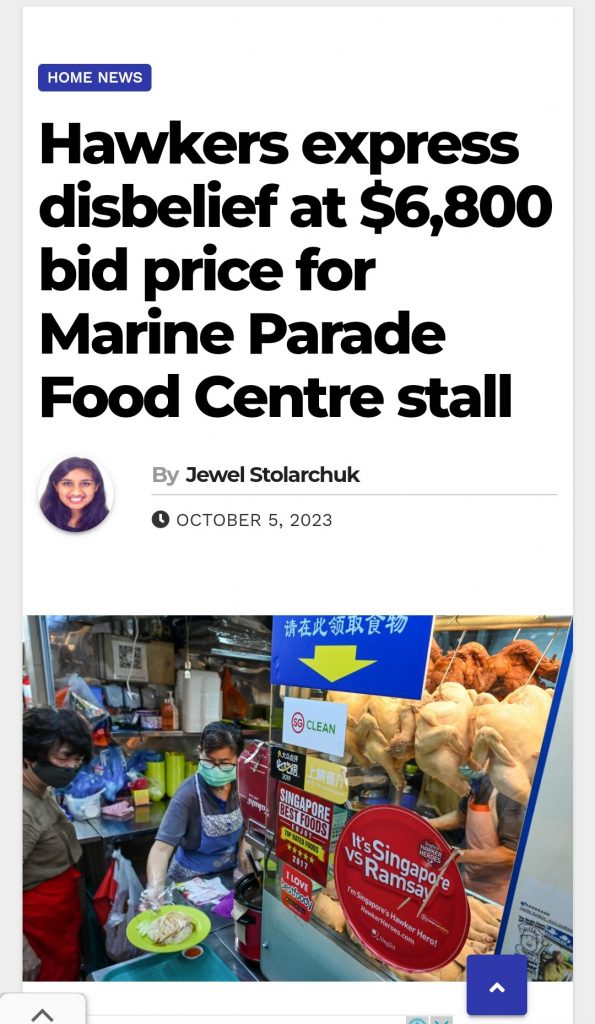
2. Their rentals at SEHCs, average $2,000.00 (with gst, they are not exempt), monthly and there is no rent distinction for whether you sell a low-cost snack that is popularly but not commonly eaten (like muah chee, ting ting tang, peanut crumble popiah, or trishaw noodles) but proud members of our culinary culture. This systematically dulls the great Singapore hawker menu as it forces them to just sell what is popular and money churners. You should differentiate rentals for stall offering vanishing or fading items. Don’t we have enough bak chor mee, fishball noodle, wanton mee, porridge, chicken rice and nasi lemak stalls already?
3. Hawkers at a SEHC pay full rates for cleaning and washing of utensils and crockery, BUT this operator has the gall to charge for the return of each plate back to the stall from the stewarding room. At $6 a rack of about 30 plates and bowls each, it can come up to $1000.00 per month, that is over and above the average $650.00 cleaning and washing fee, plus Service and Conservancy Charges of $380.00. Creative, no. Daylight robbery, yes.
(HAWKER’S CLARIFICATION– the hawker clarified that $650 is paid for washing, clearing of the tables, but the management washes the crockery and utensils and returns to them at $6 per rack of about 30-35 plates, depending on size. The hawkers need a few racks a day.)
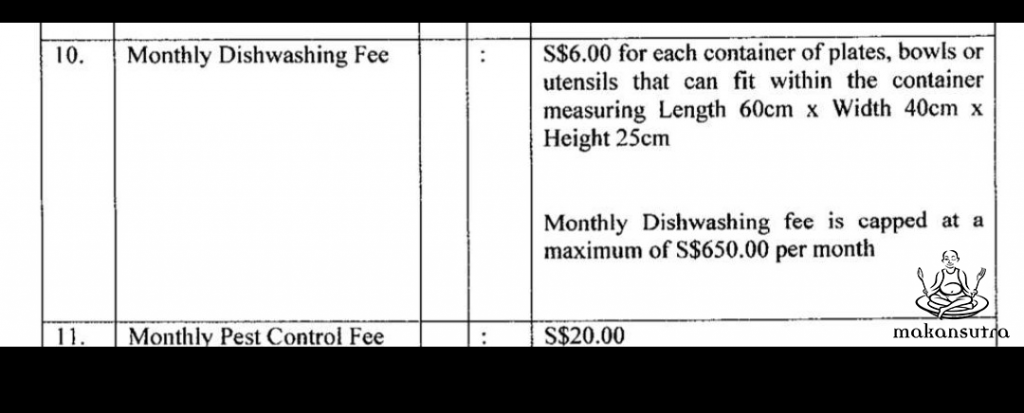
(S$6.00 for each bucket returned to hawker)
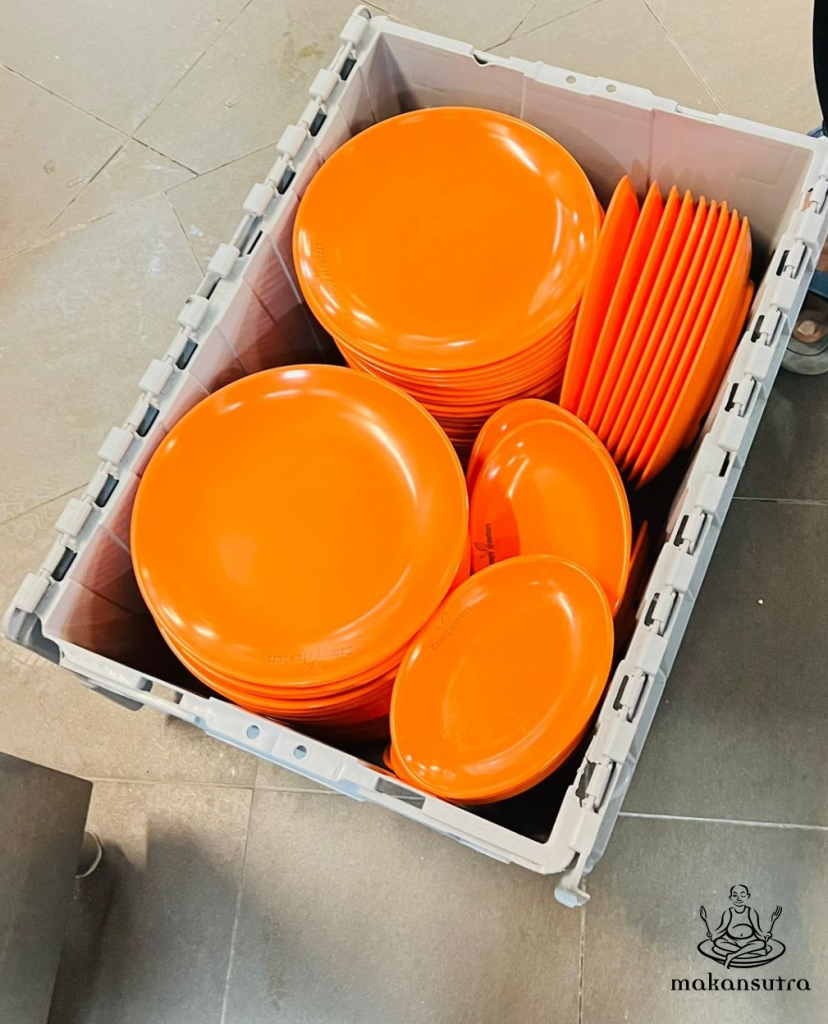
(S$6.00 to carry that from washing centre to hawker stall)
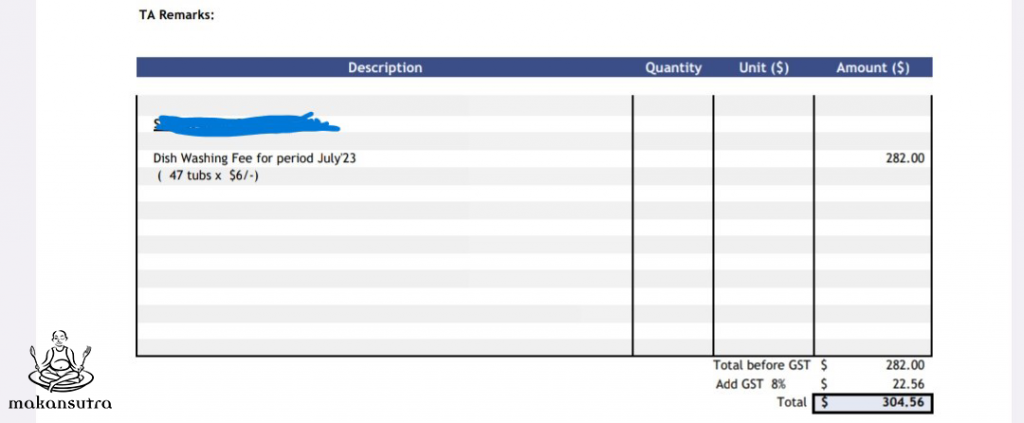
(initial bill for box of crockeries returned to hawker)
4. There is a clause, that demands hawker charge a full meal (not some side dish) at $3 or under, obviously to cater to the low wage or jobless retirees (despite these inflationary times). I am sure the hawker will gladly offer them, sometimes even for free. But reality is, the well-heeled swoop in for these cheap meals, asking for more chilli, sauce, soups and extra plates and utensils. There’s even a forced clause to demand hawkers offer 30 “pay it forward meals” every month. Charity should come from the heart, not a contract.

(Forced acts of pay-it-forward charity)
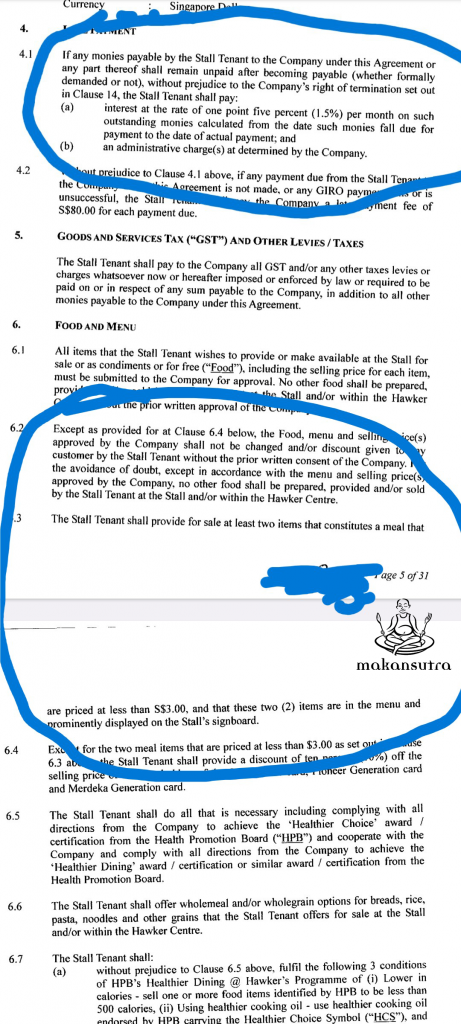
(Late payment fees and forced low price sale)

(Menu and calorie control)
5. Hawkers cannot use their own plates or bowls, they have to buy it from the SEHC “approved” supplier with the SEHC company logo (paid by hawker) stamped on it. It really limits the creative presentation by hawkers. And it’s not of much use should the hawker move to another hawker centre.
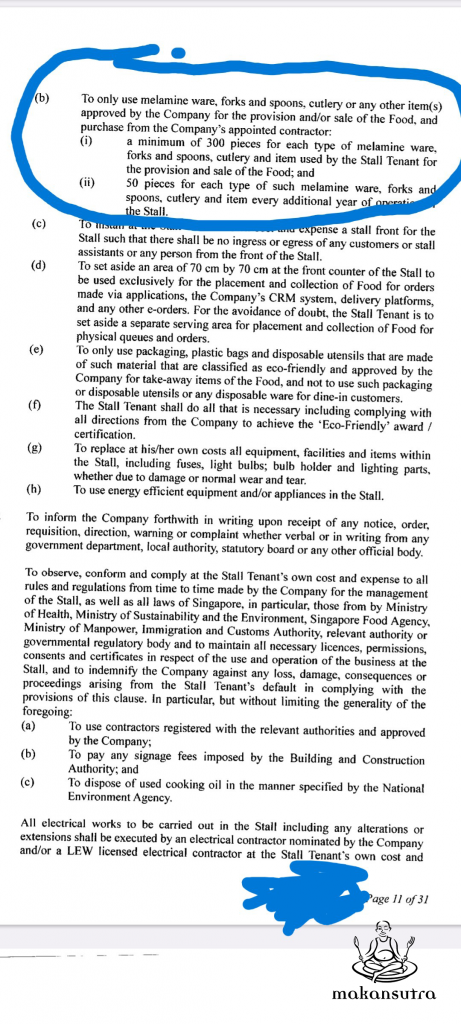
(Only purchase from approved suppliers and with SEHC logo)
6. Some hawkers sourced for and suggested a cheaper and equally reputable central gas supplier to the SEHC (up to 30% cheaper). It can amount to substantial savings over the long term, but it was shot down with a take it or leave it kind of response.

(30% more for gas supplier)

(Only appointed gas supplier)
7. And as NTUC systematically takes over management of more hawker centres, there’s no justification of why and there’s not even a finger lifted by NTUC to help hawkers obtain cheaper daily needs like salt, rice, sugar and noodles or soy sauce etc. At about $2000.00 a stall at Old Airport Road Hawker Centre, multiplied over 180 stalls plus and average $500 for cleaning and collection (no washing) it comes up to a healthy $5.4 million a year. Question is, just how much NEA is collecting from NTUC to take this responsibility off them, and that’s just one hawker centre.
8. Hawker culture is no longer just about the environment anymore (clogged drains, dirty water, bad ventilation etc), the standard has been set and appreciated. Today it is about promoting and preserving the culture, tourism, entrepreneurism, culture and community, and skills education. Seriously, it’s not up the alley nor is the gambit of NEA (National Environment Agency). They should consider backing off or relinquishing their role and responsibility of Hawker Centres and work with the tourism, trade and industry, culture and community, and skills education departments. Just regulate and help keep the place clean, as you already are do.
9. Hawkers at some of these SEHC, cannot take leave of absence– whether annual leave, emergency or health reasons. It has to be approved ahead by the SEHC operators or a fine will be imposed. You have to let them know you’re gonna fall sick ahead to time. A fine of $100 a day is charged for each day not approved by the SEHC.
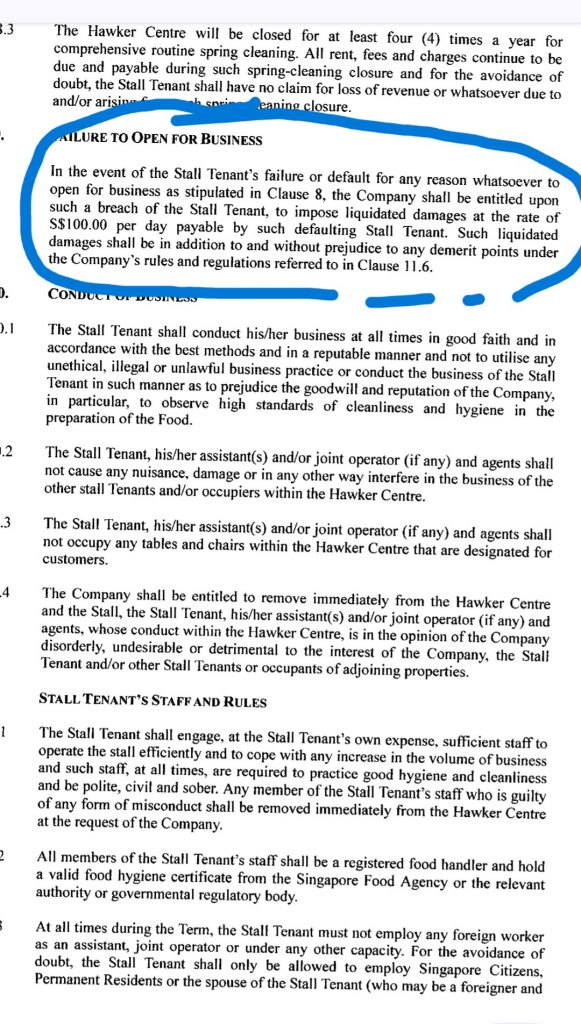
(Absentee fines)
10. And, god forbid, they charge a profit percentage or what industry calls a Gross Turnover (GTO) if the hawkers hit a certain sales target or mark of up to 15%. Ridiculous!

(A 15% GTO for hawkers)
11. Last but not least, a SEHC charge a monthly fee for that little space outside of the stall where suppliers come early and leave the goods at. That’s incredible, how do you justify this public built space. I ask, where do all these profits go to? Does it benefit the hawkers and the public at large? Remember what the role of a hawker centre is, from the get go.

(Supplier space rental each month)
In short, hawkers don’t just pay rent and cleaning fees. The rents, S&CC fees, table cleaning fees, dishwashing, plates returned to hawker cost, and the breathless laundry list of fines, can come up to over $4,000 a month.
In 2020, Singapore obtained a Unesco nod and recognition for her unique hawker food culture. They renew this award every 6 years if effort is made to preserve, sustain and promote it. I don’t think it checks out as it were.
I really believe the hawkers should form some kind of an independent Hawkers Association or entity, to protect their own viability and livelihood, with legal, finance, industry experts and communication professionals on board as advisors. The hawkers, across all platform, need a voice.
You are putting so much effort for the wrong outcome and reason. And don’t get me started on the environmental issues, like single use utensils, styrofoam and plastics, and of course manpower for them.
A new generation of leadership is afoot, please have a big rethink on this, I urge you.
(7th May 2024)


